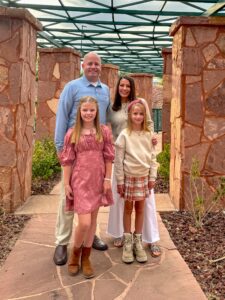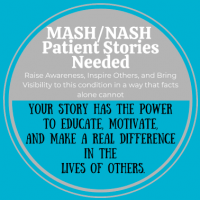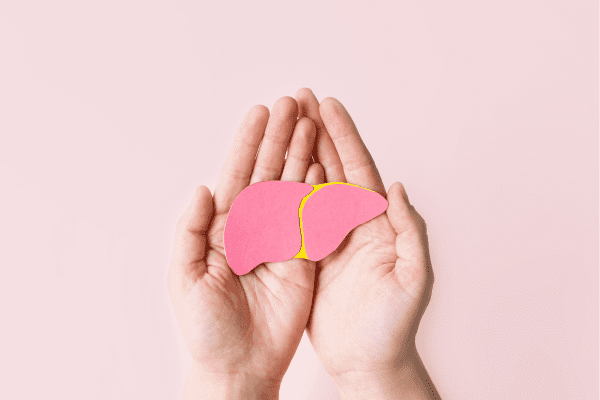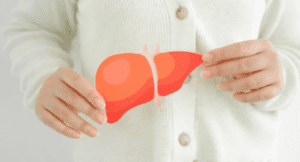My name is Danielle, and in 2021, I was diagnosed with Stage 3 MASH, a life-threatening liver disease. I consider myself lucky because I had no real symptoms; my MASH was detected almost by accident during routine blood tests to monitor two other health conditions I have: Graves’ Disease and PCOS.
I remember the day I was diagnosed so clearly it could’ve been yesterday. I texted my husband the news because I couldn’t imagine telling him face to face how serious my situation was. When I got home that night, I had to literally turn my back on him and my very young children so they wouldn’t see me cry when I imagined leaving him all alone to raise them if I couldn’t fix it in time.
At the time of my diagnosis in 2021, there was no cure or therapeutic treatment fo r MASH; the only plan was to eat the very best you could with the hope of delaying its progress. Since I was already Stage 3 at diagnosis with a fairly healthy diet, I felt devoid of hope. I was literally afraid to put food in my mouth. Food was a danger, and it was threatening to take me from my family.
r MASH; the only plan was to eat the very best you could with the hope of delaying its progress. Since I was already Stage 3 at diagnosis with a fairly healthy diet, I felt devoid of hope. I was literally afraid to put food in my mouth. Food was a danger, and it was threatening to take me from my family.
Thankfully, I was fortunate to receive an immediate referral to Mayo Clinic and traveled out of state to their Phoenix campus to be cared for by their skilled hepatologists and transplant specialists. My personality dictates that I face all challenges and worries head-on, so I was honest with my Mayo Clinic specialists about my fears and inability to eat, and they immediately set me up with a nutritionist who specializes in MASH. She guided me in understanding how to make healthier swaps for my favorite foods and helped me establish macros I could track to ease my worries about what I was eating. Eating simply became a math equation: what combination of items can I put in my mouth each day to give me the calories needed to live WITHOUT letting my liver kill me? And I lived with that mindset every day for two years.
The still very restrictive diet improved my liver levels somewhat, but after two years of daily worry, I saw my blood test levels creeping back up despite my efforts. Again, I spoke to the team at Mayo Clinic, whom I trust so much, and we decided together that I would try a medication called Semaglutide, which at the time was undergoing clinical trials to determine if it could improve MASH or its precursor MASLD (at the time referred to as NASH and NAFLD).
Because Semaglutide, branded as Ozempic, was not yet approved by the FDA to treat my disease, I was faced with a $1,400 per month pharmacy copay. For me and for most, this was simply impossible to afford—and my life depended on it.
I’m fortunate to have an amazing endocrinologist who manages my PCOS and Graves’ Disease, and after explaining my situation to her, she told me that her practice contracts with a legitimate pharmacy to offer compounded versions of Semaglutide at a lower cost, though still hundreds of dollars per month. I’m normally very risk-averse, and my research did show there were very real risks to using compounded medications, but it was a life-or-death situation for me, and I accepted the risk.
The first few months were very hard, getting my body acclimated to this drug, and I did experience an effectiveness issue with one particular compounding pharmacy that made me resolve to switch to the official drugs the moment I could afford to.
Then just last year, on a Tuesday in April, after almost exactly one year of using compounded Semaglutide, my doctors at Mayo Clinic informed me that my latest elastography imaging showed complete healing of my liver. Not only was the invasive fat gone—the fibrosis, the actual scarring of my liver from years of disease—was gone too. And I would live.
Semaglutide, my doctors at Mayo Clinic informed me that my latest elastography imaging showed complete healing of my liver. Not only was the invasive fat gone—the fibrosis, the actual scarring of my liver from years of disease—was gone too. And I would live.
In under a year, my life had already changed. I had more energy to spend on my kids, less daily worry that doing my best wouldn’t be enough, and more seeing food as a resource to be enjoyed responsibly and less as a daily burden.
I have so much hope now where there was none before, and it’s only getting better. Just this August, the FDA approved Semaglutide, under the brand name Wegovy, for use by MASH patients. I immediately petitioned my employee health benefits committee to cover Wegovy for MASH patients, and in a vote of 5 to 2, was able to get coverage granted immediately. So far, I’m the only MASH patient on our plan, but I know I won’t be the last, and the next person will have a much clearer path thanks to my advocacy.
I remember so clearly what those years of worry and sickness and hopelessness and crushing expense felt like. It’s my mission now to speak up for other MASH patients and to advocate for access and affordability when it comes to making this diagnosis manageable. There is so much hope on the horizon for MASH patients, and it’s a privilege for me to still be here to share my story.









